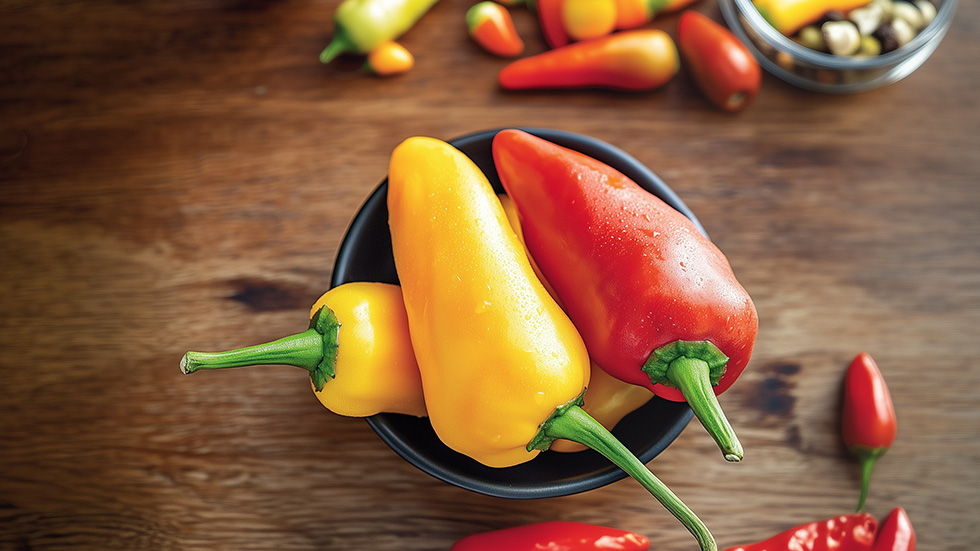Lecso peppers – the tasty, crunchy gift of summer
Lecso peppers are not actually a separate variety, but a quality category of edible peppers(Capsicum annuum), such as Hungarian white peppers or stuffing peppers. It is usually used to describe fruits that do not meet the most stringent selection criteria in terms of size, shape or colour, and are therefore not classified as premium, but are perfectly fine in terms of taste and nutritional value.

The lecso pepper is a real staple in the home kitchen. If there’s one vegetable that can be found in almost every Hungarian household during the summer months, it’s this one. It’s no coincidence, since “lecsópaprika” is one of our favourite seasonal vegetables – cheap, versatile and delicious! 🌞
The lecso pepper is a real staple in the home kitchen. If there’s one vegetable that can be found in almost every Hungarian household during the summer months, it’s this one.
Its origins go back to Central and South America, but in Europe it has played a major role in gastronomy since the 16th century. It is particularly popular in Hungary, where lecsó would be unthinkable without it! 🇭🇺
How important is it in the kitchen?
Rating: 5/5
Lecso pepper is of great importance in Hungarian cuisine. In addition to lecsó, it is also used as a stuffed pepper, pickle, base for stews or even raw with sandwiches. It is also popular in Europe, especially in Middle Eastern countries, where it is prepared in a similar way to ours. This pepper is simply everywhere you want a truly homey taste.
Which part is edible?
The hollow fruit of the lecso pepper is edible. The crunchy skin, the fleshy wall, the seedless inside are all edible, tasty and refreshing. However, the skin and seeds are removed as they can be bitter and are not very pleasant to chew. The stems are also inedible and are often sold cut off in the shop.
Health benefits
Not only are lecso peppers delicious, they are also healthy! It is rich in vitamin C, which supports immune function, as well as vitamin B6, folic acid, potassium and antioxidants. Traditional medicine suggests that regular consumption can help:
- strengthen the immune system,
- reduce inflammation,
- support cardiovascular health,
- help digestion,
- make dieting easier, as it is low in calories but filling.
Production: season, background and origin
The lecso pepper can be grown both in the open field and in a greenhouse. The season in Hungary lasts from June to the end of September, but the greenhouse varieties may be available from April. The best quality home-grown peppers are usually available in markets and shops between July and August.
Spain and the Netherlands are among Europe’s biggest pepper producers, using modern greenhouse technology to grow a variety of peppers all year round, including white varieties like the snap pepper. If you want peppers in winter, you’re likely to find an imported product.
How to choose a really good lecso pepper?
The good-quality bell peppers:
- even, pale yellowish colour, possibly with a slight greenish or cream tinge,
- firm to the touch and solid, not dented,
- skin smooth, shiny, without wrinkles or blemishes,
- stems are fresh green – if they are brown or wilted, they are not fresh.
Storage tips
It’s a good idea to keep the chillies in the fridge, in a vegetable storage compartment, in an airtight bag or paper bag. This will keep them fresh for up to 5-7 days. Do not wash it in advance, as moisture makes it spoil more easily! If you do buy a lot, you can freeze it – chopped and sliced is most practical.
In the kitchens of the world
Although perhaps best known in Hungarian cuisine, peppers similar to lecso peppers are also popular in other nations. Turkish “menemen”, French “ratatouille” or Spanish “pisto” are all vegetable dishes in which paprika plays an important role. Mediterranean and Balkan cuisines often stuff, grill or pickle these peppers.
Iconic recipe: the classic lecsó
Ingredients:
- 1 kg of bell peppers
- 50 dkg tomatoes
- 1 head of onion
- 1 tablespoon fat or oil
- salt, pepper, optionally paprika or sausage
Sauté the onion in the fat until translucent, then add the diced pepper. Sauté together for a few minutes, then add the tomatoes. Season with salt and pepper and cook over a low heat. The basic recipe can be enriched with eggs, rice, sausages or even bacon – it’s all a matter of taste!
Tips for using it in the kitchen
Lecso peppers are a great match:
- for stews, roasts and grilled dishes,
- in casseroles,
- cold for salads,
- with roast meats,
- covered in pickles,
- or just as it is, with bread, freshly sliced.
Spices that go well with it: garlic, red pepper, ground cumin, marjoram, basil, parsley.
What to avoid: cinnamon, nutmeg, vanilla – these are not in play in the world of chilli peppers 😄
So next time you’re at the market and you smell fresh lecso peppers, don’t hesitate! A good chilli pepper is always great in the kitchen – it’s refreshing, healthy and brings out the best in everything!
